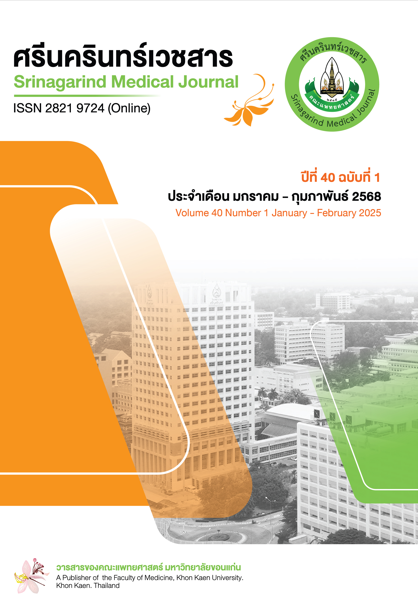Impact of Cerebrovascular Disease on Treatment Outcome of Patients with Non-Variceal Upper Gastrointestinal Bleeding
Keywords:
non-variceal upper gastrointestinal bleeding, cerebrovascular disease, mortality, clinical outcome, medical resourceAbstract
Background and Objective: Upper gastrointestinal bleeding (UGIB) is a significant and common issue in clinical practice, with treatment outcomes largely influenced by patients’ comorbidities. Cerebrovascular disease (CVD) may impact UGIB due to associated conditions, such as cardiovascular diseases and the use of antiplatelet or anticoagulant medications, which can exacerbate bleeding severity and affect treatment response. This study aimed to evaluate the impact of CVD on clinical outcomes and hospital resource utilization in patients with non-variceal UGIB (NVUGIB).
Methodology: This retrospective study included patients diagnosed with NVUGIB who were treated at Hatyai Hospital between January 2016 and December 2019. Clinical data, laboratory results, and treatment outcomes were collected and analyzed to compare in-hospital mortality and other treatment outcomes between patients with and without CVD.
Results: A total of 488 patients with NVUGIB were included, comprising 22 patients with CVD and 466 without CVD. No significant differences were observed between the two groups in terms of in-hospital mortality (4.9% vs. 0%, p=1.000), endoscopic intervention rates (23.6% vs. 22.7%, p=0.924), radiological intervention rates (1.1% vs. 0%, p=1.000), surgical intervention rates (2.1% vs. 0%, p=1.000), or in-hospital re-bleeding (4.3% vs. 0%, p=1.000). Median blood transfusion units [interquartile range] were 1 [0–3] vs. 2 [0–4] (p=0.147). Median hospital stay duration was 4 [3–6] days vs. 4 [3–7] days (p=0.697), and median treatment costs were 17,972 [14,025–28,920] THB vs. 19,659 [14,882–31,212] THB (p=0.830). No associations between CVD and treatment outcomes or hospital resource utilization were identified (all p >0.05).
Conclusions: This study found no differences in in-hospital mortality, treatment outcomes, or healthcare resource utilization during hospitalization between patients with and without a history of cerebrovascular disease in cases of non-variceal upper gastrointestinal bleeding.
References
Laine L, Barkun AN, Saltzman JR, Martel M, Leontiadis GI. ACG clinical guideline: upper gastrointestinal and ulcer bleeding. Am J Gastroenterol 2021;116(5):899-917. doi:10.14309/ajg.0000000000001506.
Barkun AN, Almadi M, Kuipers EJ, Laine L, Sung J, Tse F, et al. Management of nonvariceal upper gastrointestinal bleeding: Guideline recommendations from the international consensus group. Ann Intern Med 2019;171(11):805-22. doi:10.7326/M19-1795.
Garcia-Tsao G, Abraldes JG, Berzigotti A, Bosch J. Portal hypertensive bleeding in cirrhosis: Risk stratification, diagnosis, and management: 2016 practice guidance by the American Association for the study of liver diseases. Hepatology 2017;65(1):310-35. doi:10.1002/hep.29169.
Chang A, Ouejiaraphant C, Pungpipattrakul N, Akarapatima K, Rattanasupar A, Prachayakul V. Effect of holiday admission on clinical outcome of patients with upper gastrointestinal bleeding: A real-world report from Thailand. Heliyon 2022;8(8):e10344. doi:10.1016/j.heliyon.2022.e10344.
Lau JYW, Yu Y, Tang RSY, Chan HCH, Yip HC, Chan SM, et al. Timing of endoscopy for acute upper gastrointestinal bleeding. N Engl J Med 2020;382(14):1299-308. doi: 10.1056/NEJMoa1912484.
Chang A, Ouejiaraphant C, Akarapatima K, Rattanasupa A, Prachayakul V. Prospective comparison of the AIMS65 score, Glasgow-Blatchford score, and Rockall score for Predicting clinical outcomes in patients with variceal and nonvariceal upper gastrointestinal bleeding. Clin Endosc 2021;54(2):211-221. doi:10.5946/ce.2020.068.
Sung JJ, Tsoi KK, Ma TK, Yung MY, Lau JY, Chiu PW. Causes of mortality in patients with peptic ulcer bleeding: a prospective cohort study of 10,428 cases. Am J Gastroenterol 2010;105(1):84-9. doi:10.1038/ajg.2009.507.
Hu X, De Silva TM, Chen J, Faraci FM. Cerebral vascular disease and neurovascular injury in ischemic stroke. Circ Res 2017;120(3):449-71. doi:10.1161/CIRCRESAHA.116.308427.
Kuwabara K, Matsuda S, Fushimi K, Ishikawa KB, Horiguchi H, Fujimori K. Reconsidering the value of rehabilitation for patients with cerebrovascular disease in Japanese acute health care hospitals. Value Health 2011;14(1):166-76. doi:10.1016/j.jval.2010.10.028.
Lee HJ, Kim HK, Kim BS, Han KD, Park JB, Lee H, et al. Risk of upper gastrointestinal bleeding in patients on oral anticoagulant and proton pump inhibitor co-therapy. PLoS One 2021;16(6):e0253310. doi:10.1371/journal.pone.0253310.
Takabayashi N, Murata K, Tanaka S, Kawakami K. Cost-effectiveness of proton pump inhibitor co-therapy in patients taking aspirin for secondary prevention of ischemic stroke. Pharmacoeconomics 2015;33(10):1091-100. doi:10.1007/s40273-015-0289-4.
Zheng K, Xu X, Qi X, Guo X. Development of myocardial infarction and ischemic stroke after acute upper gastrointestinal bleeding. AME Case Rep 2020;4:20. doi:10.21037/acr-19-198.
Wang T, Zhu D, Kong L, Mu C, Li C, Hu L. Effect of upper gastrointestinal bleeding on prognosis of middle-aged patients with acute ischemic stroke: a retrospective study. Ann Palliat Med 2021;10(5):5494-501. doi:10.21037/apm-21-907.
Downloads
Published
How to Cite
Issue
Section
License
Copyright (c) 2025 Srinagarind Medical Journal

This work is licensed under a Creative Commons Attribution-NonCommercial-NoDerivatives 4.0 International License.



